Optimal Planning of Charging for Plug-In Electric Vehicles Focusing on Users’ Benefits
Abstract
:1. Introduction
2. Methodology Description
3. Problem Formulation and Transformation
3.1. Cost Model of Battery Capacity Fade
3.1.1. Battery Capacity Degradation Analysis
3.1.2. Cost of Battery Capacity Degradation Modeling
3.2. Electricity Cost
3.3. Grid Load Curve Optimization
- Step 1.
- Initialize the parameters visual distance, step length, population size, crowded degree, and iteration times. The visual distance and step values will decrease as the number of iterations increases. A group of artificial fish M is generated randomly in the water, and the information contained in each fish is a charging start time matrix U of all EVs. Each artificial fish here represents a charging start time scheme for all EVs.
- Step 2.
- Calculate the food concentration of each fish’s position, record the best result on the bulletin board. The food concentration (i.e., the variance of distribution network) load is calculated based on the objective function.
- Step 3.
- Artificial fishes move one step by performing one of the four kinds of behavior, which are cluster behavior, following behavior, foraging behavior, and random behavior, according to their situation.
- Step 4.
- Calculate the food concentration of each fish’s new position. Record the best result to the bulletin board if it is better than the old one.
- Step 5.
- If the ending condition is met, finish the algorithm. If not, go to step 3.
3.4. Queuing Theory for Busy Areas
4. Numerical Results
4.1. Regular Routes Planning Simulation
4.1.1. Monte Carlo Method
4.1.2. Results of Regular Routes Simulation
4.2. Irregular Routes Planning Simulation
5. Conclusions
- A cost model of battery capacity degradation is developed to estimate the cost of battery capacity degradation, which is usually not paid much attention by EV users. The optimal SOC range planning based on this model enables the the cost of battery degradation to be significantly reduced.
- For regular routes, to keep the operating cost low for the routes, such as commuting, charging time is also shifted to achieve the lowest electricity cost.
- For regular routes, the grid operation is optimized by AFSA with constraints which occur in the process of maximizing EV users’ benefit. In the meantime, the daily load curve in the distribution network can still be flattened markedly.
- For irregular routes, the average queue time is greatly decreased due to the application of queuing theory, and the cost of battery degradation is also reduced by the SOC range planning based on the cost model of battery degradation.
Acknowledgments
Author Contributions
Conflicts of Interest
References
- Hannan, M.A.; Azidin, F.A.; Mohamed, A. Hybrid electric vehicles and their challenges: A review. Renew. Sustain. Energy Rev. 2014, 29, 135–150. [Google Scholar] [CrossRef]
- Hilshey, A.D.; Rezaei, P.; Hines, P.D.H.; Frolik, J. Electric vehicle charging: Transformer impacts and smart, decentralized solutions. In Proceedings of the Power and Energy Society General Meeting, San Diego, CA, USA, 22–26 July 2012; pp. 1–8. [Google Scholar]
- Masoum, A.S.; Deilami, S.; Moses, P.S.; Masoum, M.A.S.; Abu-Siada, A. Smart load management of plug-in electric vehicles in distribution and residential networks with charging stations for peak shaving and loss minimisation considering voltage regulation. IET Gener. Transm. Distrib. 2011, 5, 877–888. [Google Scholar] [CrossRef]
- Razeghi, G.; Zhang, L.; Brown, T.; Samuelsen, S. Impacts of plug-in hybrid electric vehicles on a residential transformer using stochastic and empirical analysis. J. Power Sources 2014, 252, 277–285. [Google Scholar] [CrossRef]
- Fernandez, L.P.; Roman, T.G.S.; Cossent, R.; Domingo, C.M.; Frias, P. Assessment of the impact of plug-in electric vehicles on distribution networks. IEEE Trans. Power Syst. 2011, 26, 206–213. [Google Scholar] [CrossRef]
- Richardson, P.; Flynn, D.; Keane, A. Optimal charging of electric vehicles in low-voltage distribution systems. IEEE Trans. Power Syst. 2012, 27, 268–279. [Google Scholar] [CrossRef]
- Chis, A.; Lunden, J.; Koivunen, V. Scheduling of plug-in electric vehicle battery charging with price prediction. In Proceedings of the Innovative Smart Grid Technologies Europe, Lyngby, Denmark, 6–9 October 2013; pp. 1–5. [Google Scholar]
- Zheng, J.; Wang, X.; Men, K.; Zhu, C.; Zhu, S. Aggregation model-based optimization for electric vehicle charging strategy. IEEE Trans. Smart Grid 2013, 4, 1058–1066. [Google Scholar] [CrossRef]
- Aziz, M.; Oda, T.; Mitani, T.; Watanabe, Y.; Kashiwagi, T. Utilization of electric vehicles and their used batteries for peak-load shifting. Energies 2015, 8, 3720–3738. [Google Scholar] [CrossRef]
- Alam, M.; Mekhilef, S.; Seyedmahmoudian, M.; Horan, B. Dynamic charging of electric vehicle with negligible power transfer fluctuation. Energies 2017, 10, 701. [Google Scholar] [CrossRef]
- Sortomme, E.; Hindi, M.M.; Macpherson, S.D.J.; Venkata, S.S. Coordinated charging of plug-in hybrid electric vehicles to minimize distribution system losses. IEEE Trans. Smart Grid 2011, 2, 198–205. [Google Scholar] [CrossRef]
- Hu, Z.; Zhan, K.; Zhang, H.; Song, Y. Pricing mechanisms design for guiding electric vehicle charging to fill load valley. Appl. Energy 2016, 178, 155–163. [Google Scholar] [CrossRef]
- Yang, J.; Chen, J.; Chen, L.; Wang, F.; Xie, P.; Zeng, C. A regional time-of-use electricity price based optimal charging strategy for electrical vehicles. Energies 2016, 9, 670. [Google Scholar] [CrossRef]
- Hu, J.; Yang, G.; Kok, K.; Xue, Y.; Bindner, H.W. Transactive control: A framework for operating power systems characterized by high penetration of distributed energy resources. J. Mod. Power Syst. Clean Energy 2016, 5, 451–464. [Google Scholar] [CrossRef]
- Hao, H.; Corbin, C.D.; Kalsi, K.; Pratt, R.G. Transactive control of commercial buildings for demand response. IEEE Trans. Power Syst. 2017, 32, 774–783. [Google Scholar] [CrossRef]
- Jin, X.; Meintz, A. Challenges and Opportunities for Transactive Control of Electric Vehicle Supply Equipment. A Reference Guide; NREL/TP--5500-64007; National Renewable Energy Laboratory (NREL): Golden, CO, USA, 2015.
- Yagcitekin, B.; Uzunoglu, M. A double-layer smart charging strategy of electric vehicles taking routing and charge scheduling into account. Appl. Energy 2016, 167, 407–419. [Google Scholar] [CrossRef]
- Liu, D.; Wang, Y.; Shen, Y. Electric vehicle charging and discharging coordination on distribution network using multi-objective particle swarm optimization and fuzzy decision making. Energies 2016, 9, 186. [Google Scholar] [CrossRef]
- Chen, L.; Chen, Z.; Huang, X.; Jin, L. A study on price-based charging strategy for electric vehicles on expressways. Energies 2016, 9, 385. [Google Scholar] [CrossRef]
- Ouyang, M.; Feng, X.; Han, X.; Lu, L.; Li, Z.; He, X. A dynamic capacity degradation model and its applications considering varying load for a large format li-ion battery. Appl. Energy 2016, 165, 48–59. [Google Scholar] [CrossRef]
- Liu, D.; Luo, Y.; Liu, J.; Peng, Y.; Guo, L.; Pecht, M. Lithium-ion battery remaining useful life estimation based on fusion nonlinear degradation AR model and RPF algorithm. Neural Comput. Appl. 2014, 25, 557–572. [Google Scholar] [CrossRef]
- Saxena, S.; Hendricks, C.; Pecht, M. Cycle life testing and modeling of graphite/LiCoO2 cells under different state of charge ranges. J. Power Sources 2016, 327, 394–400. [Google Scholar] [CrossRef]
- Diao, Q.; Sun, W.; Yuan, X.; Li, L.; Zheng, Z. Life-cycle private-cost-based competitiveness analysis of electric vehicles in China considering the intangible cost of traffic policies. Appl. Energy 2016, 178, 567–578. [Google Scholar] [CrossRef]
- Wolfs, P. An economic assessment of “second use” lithium-ion batteries for grid support. In Proceedings of the Universities Power Engineering Conference (AUPEC), Christchurch, New Zealand, 5–8 December 2010; pp. 1–6. [Google Scholar]
- Flores, R.J.; Shaffer, B.P.; Brouwer, J. Electricity costs for an electric vehicle fueling station with level 3 charging. Appl. Energy 2016, 169, 813–830. [Google Scholar] [CrossRef]
- Chen, L.; Huang, X.; Chen, Z.; Jin, L. Study of a new quick-charging strategy for electric vehicles in highway charging stations. Energies 2016, 9, 744. [Google Scholar] [CrossRef]
- Weerdt, M.M.D.; Stein, S.; Gerding, E.H.; Robu, V.; Jennings, N.R. Intention-aware routing of electric vehicles. IEEE Trans. Intell. Transp. Syst. 2016, 17, 1472–1482. [Google Scholar] [CrossRef]
- Dong, X.; Mu, Y.; Jia, H.; Wu, J.; Yu, X. Planning of fast EV charging stations on a round freeway. IEEE Trans. Sustain. Energy 2016, 7, 1452–1461. [Google Scholar] [CrossRef]
- Lih, W.; Yen, J.; Shieh, F.; Liao, Y. Second-use Applications of lithium-ion batteries retired from electric vehicles: Challenges, repurposing process, cost analysis and optimal business model. Int. J. Adv. Comput. Technol. 2012, 4, 518–527. [Google Scholar]
- Barré, A.; Deguilhem, B.; Grolleau, S.; Gérard, M.; Suard, F.; Riu, D. A review on lithium-ion battery ageing mechanisms and estimations for automotive applications. J. Power Sources 2013, 241, 680–689. [Google Scholar] [CrossRef]
- Battery Group of Center for Advanced Life Cycle. Engineering, University of Maryland. Available online: http://www.calce.umd.edu/batteries/index.html (accessed on 4 July 2017).
- City Transportation Analysis Report of China. Available online: http://jiaotong.baidu.com/reports/ (accessed on 4 July 2017).
- China Electric Car Sales Report, CleanTechnica. Available online: https://cleantechnica.com (accessed on 4 July 2017).
- U.S. Department of Transportation, Federal Highway Administration. 2009 National Household Travel Survey. Available online: http://nhts.ornl.gov (accessed on 4 July 2017).
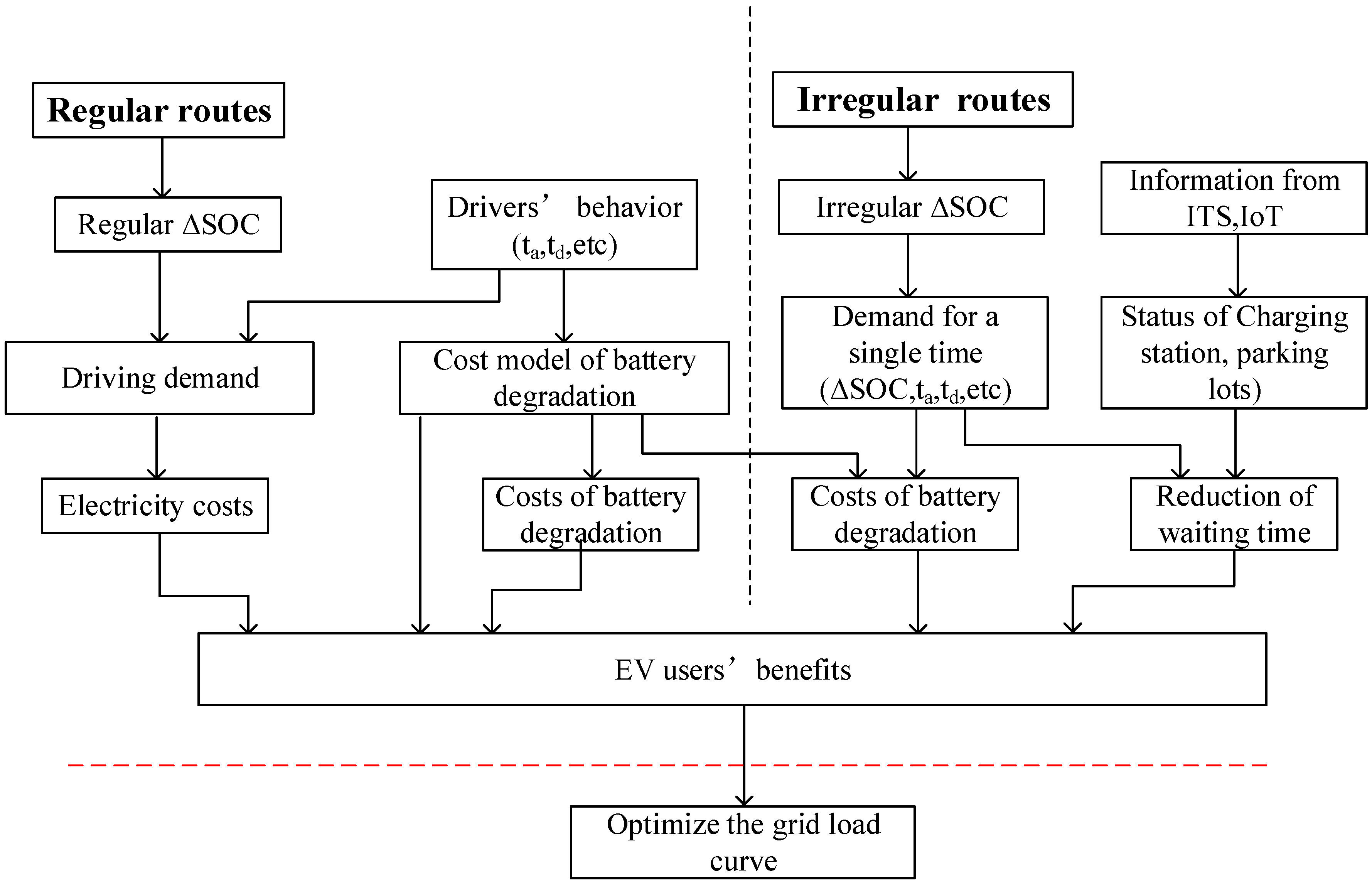

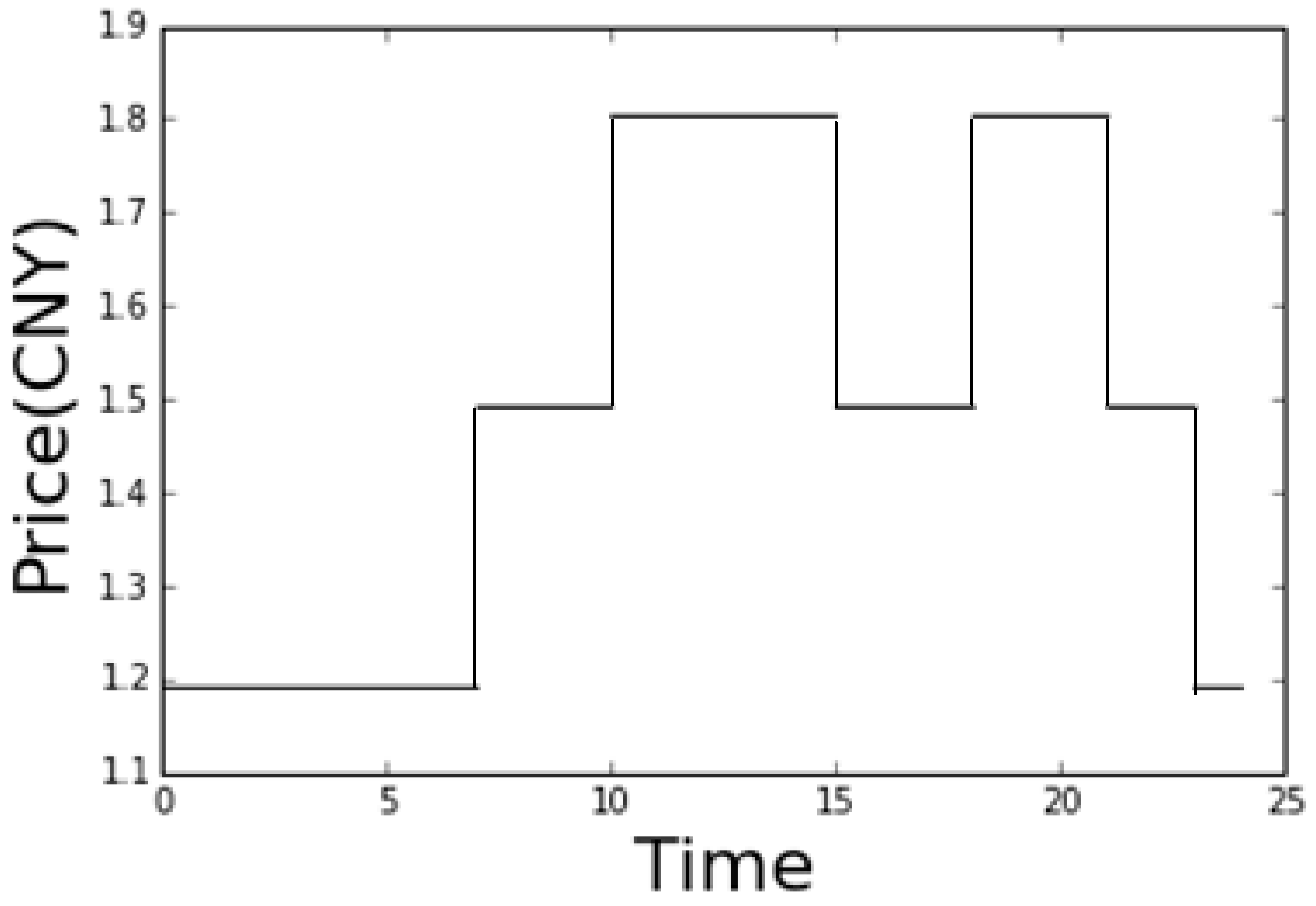
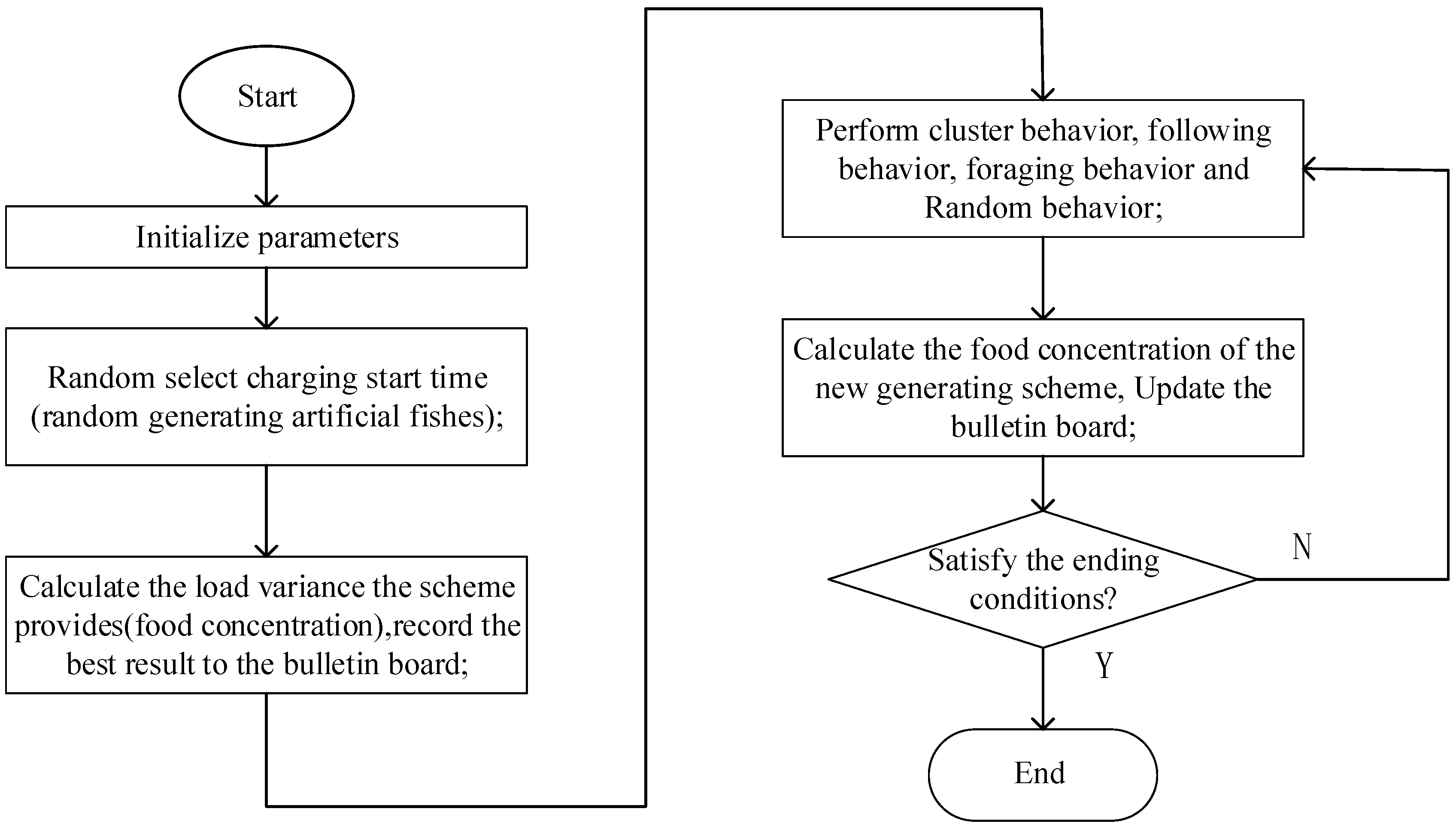



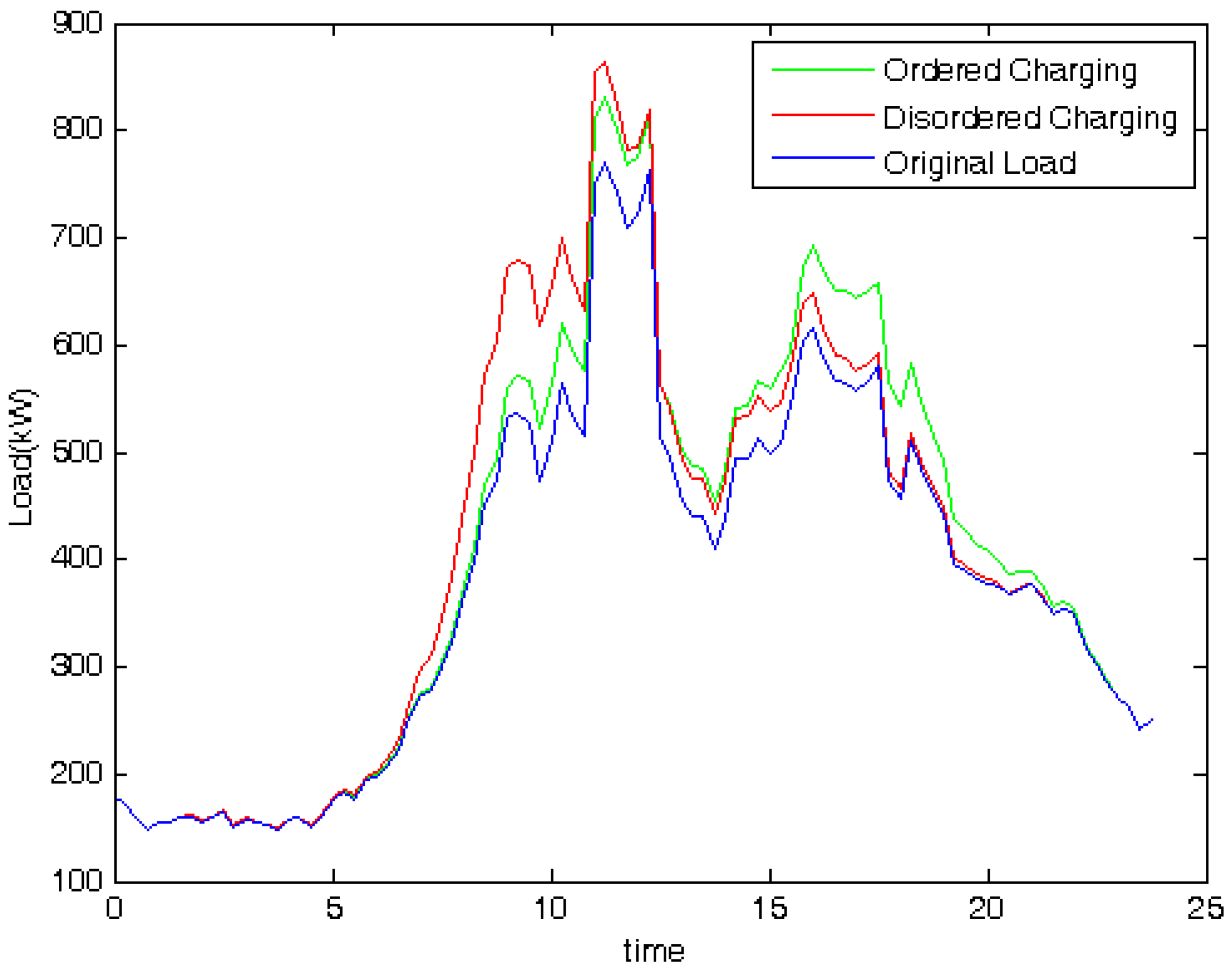
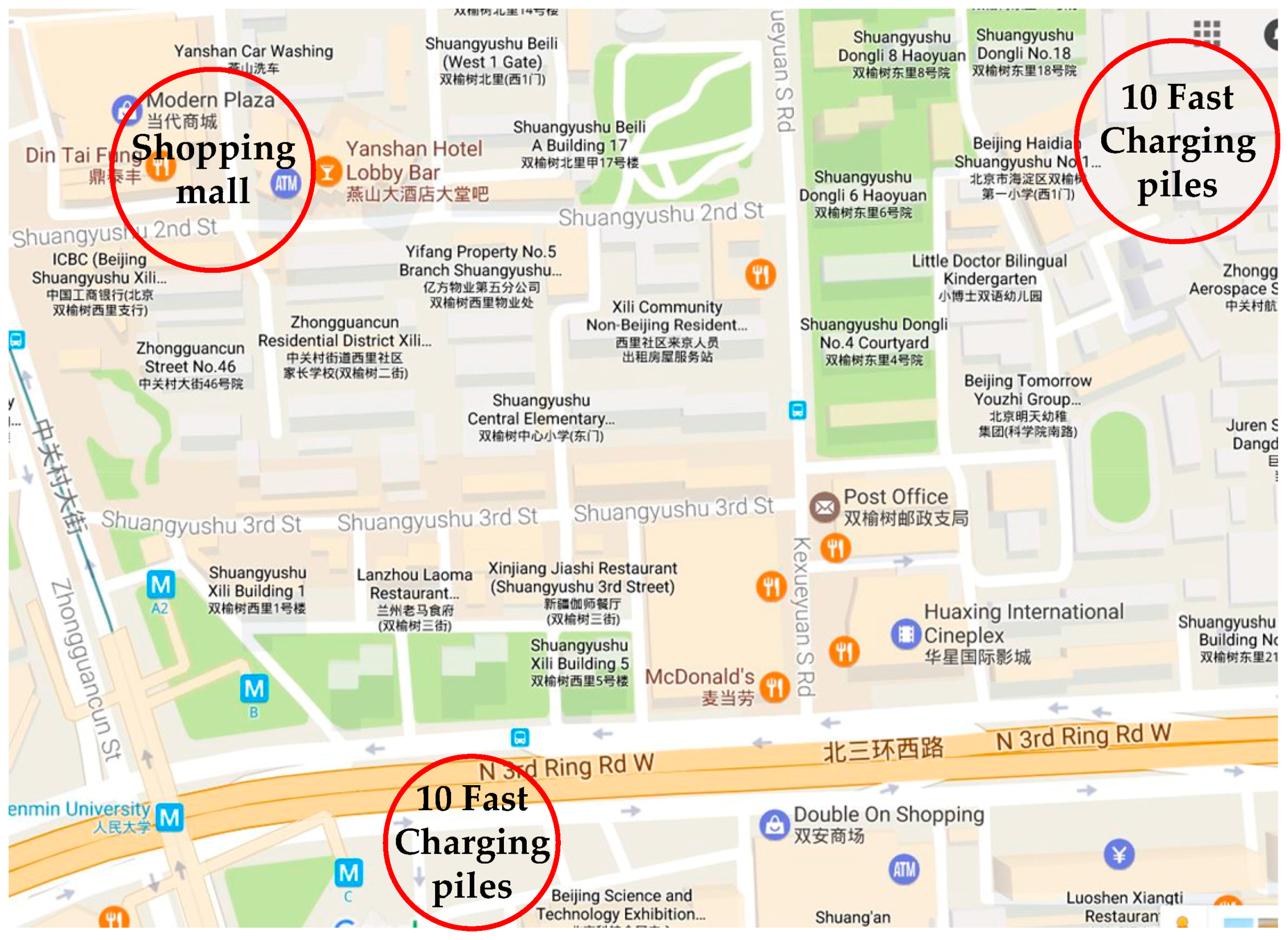
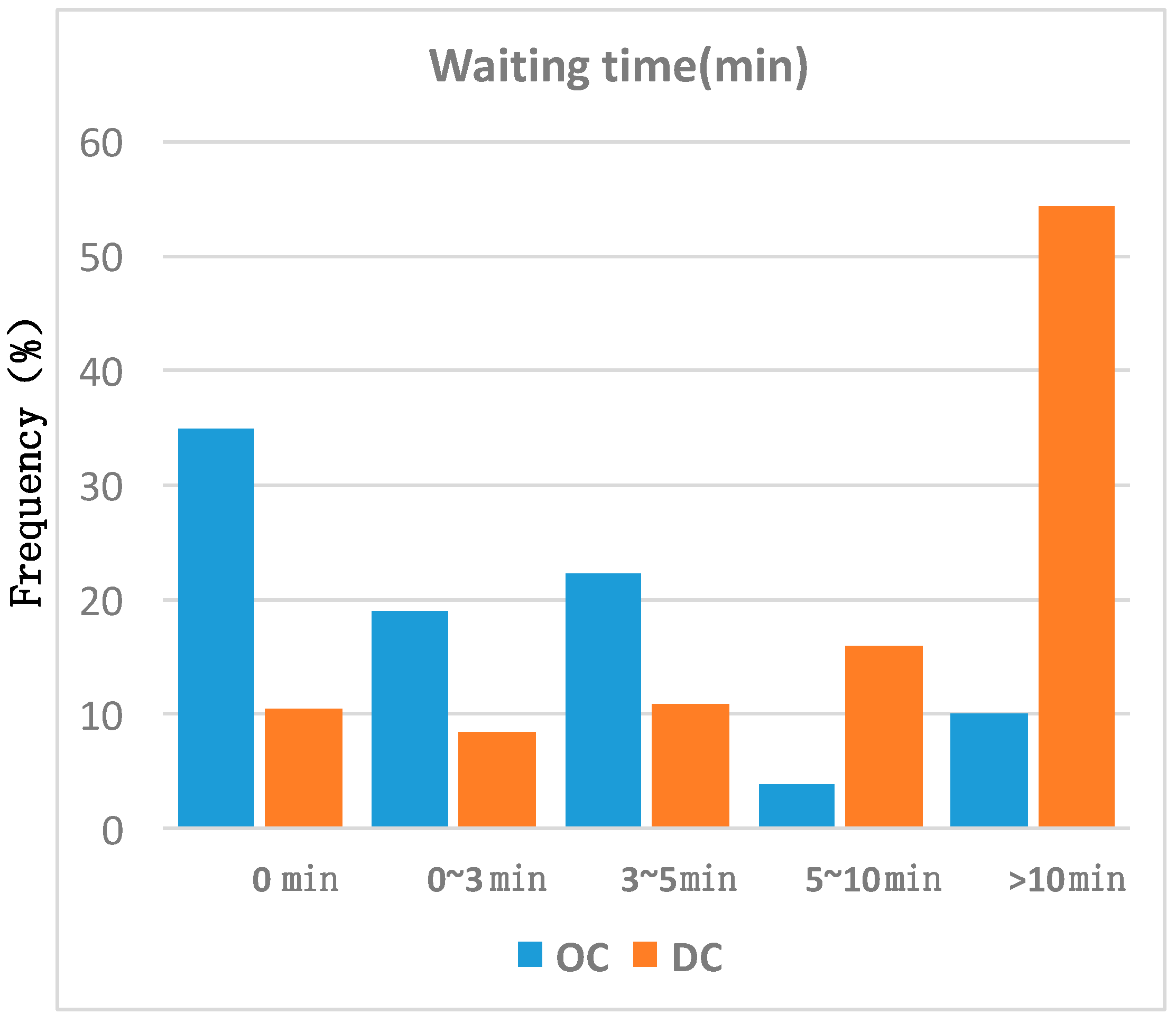
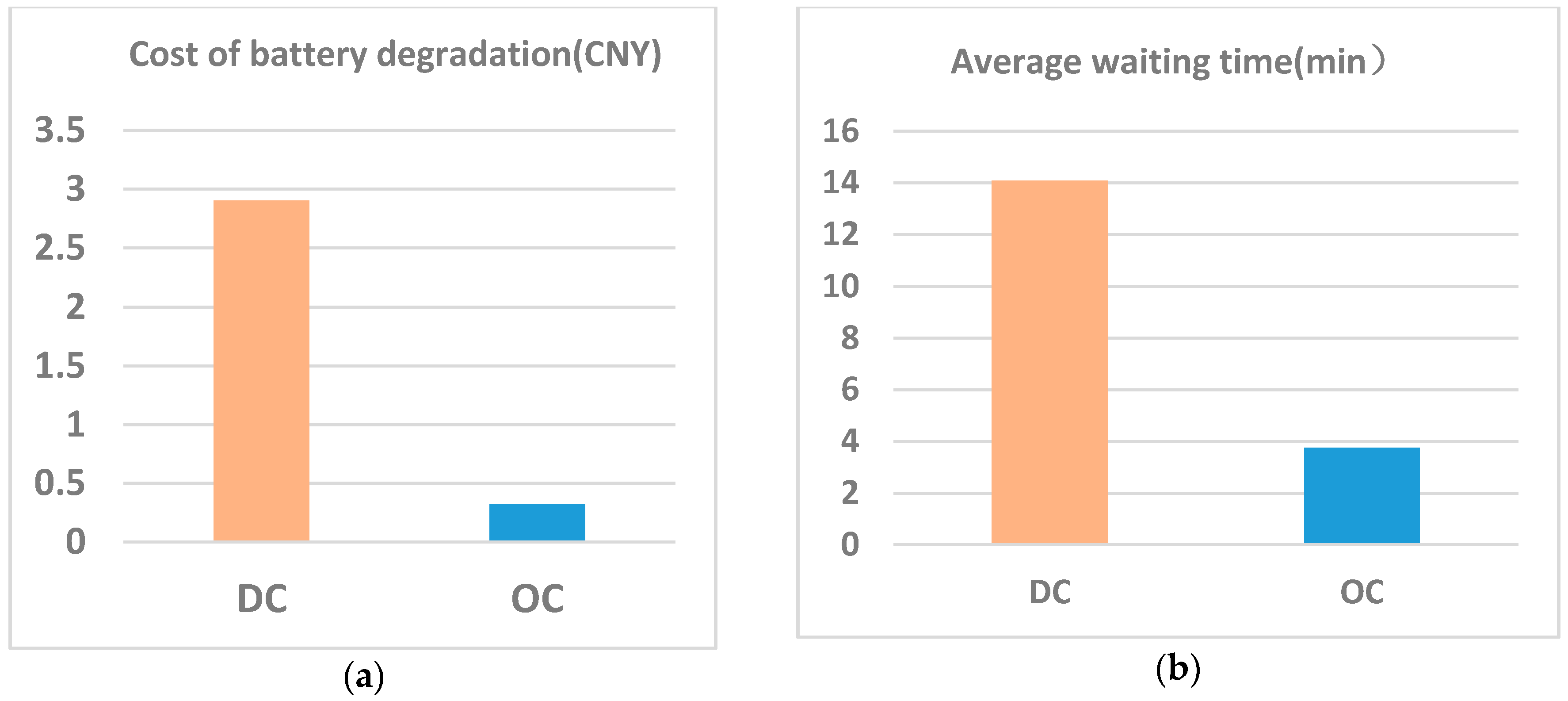
| Vehicle Type | Capacity (kWh) | Consumption (kWh/100 km) | Sales in 2016 |
|---|---|---|---|
| BYD e6 | 82 | 19.5 | 20605 |
| BAIC E-Series EV | 25.6 | 15 | 18814 |
| BAIC EU260 EV | 41.4 | 15.9 | 18805 |
| Geely Emgrand | 41 | 15.8 | 17181 |
| Operating Costs | DC | OC |
|---|---|---|
| Cost of Battery Degradation (USD) | 0.94 | 0.17 |
| Electricity Cost (USD) | 0.51 | 0.46 |
| Method | Variance | Peak (kW) | Valley (kW) |
|---|---|---|---|
| DC | 4098 | 864.0 | 442.2 |
| OC | 3885 | 822.7 | 464.7 |
| Orignal load | 3016 | 741.0 | 409.4 |
© 2017 by the authors. Licensee MDPI, Basel, Switzerland. This article is an open access article distributed under the terms and conditions of the Creative Commons Attribution (CC BY) license (http://creativecommons.org/licenses/by/4.0/).
Share and Cite
Su, S.; Li, H.; Gao, D.W. Optimal Planning of Charging for Plug-In Electric Vehicles Focusing on Users’ Benefits. Energies 2017, 10, 952. https://doi.org/10.3390/en10070952
Su S, Li H, Gao DW. Optimal Planning of Charging for Plug-In Electric Vehicles Focusing on Users’ Benefits. Energies. 2017; 10(7):952. https://doi.org/10.3390/en10070952
Chicago/Turabian StyleSu, Su, Hao Li, and David Wenzhong Gao. 2017. "Optimal Planning of Charging for Plug-In Electric Vehicles Focusing on Users’ Benefits" Energies 10, no. 7: 952. https://doi.org/10.3390/en10070952




